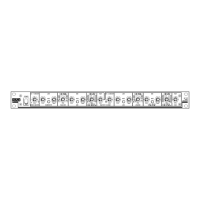
Do you have a question about the Rane AC 23 and is the answer not in the manual?
| Frequency Range | 20 Hz - 20 kHz |
|---|---|
| Slope | 12 dB/octave |
| Input Connectors | XLR, 1/4" TRS |
| Output Connectors | XLR, 1/4" TRS |
| Signal to Noise Ratio | > 100 dB |
| Input Impedance | 20 kΩ |
| Output Impedance | 100 Ω |
| Maximum Input Level | +22 dBu |
| Maximum Output Level | +22 dBu |
| Power Supply | 100-240 VAC, 50-60 Hz |
| Power Consumption | 15 W |
| Dimensions | 19" x 1.75" |
| Configuration | 2-way |
Explains how the AC 23 automatically configures based on input connections for 2/3/4/5-way modes.
Details controls for Channel 1: MASTER LEVEL, LOW LEVEL, LOW MUTE, LOW DELAY, LOW/HIGH crossover selector.
Details controls for Channel 1: MASTER LEVEL, LOW LEVEL, LOW MUTE, LOW DELAY, LOW/MID crossover, MID LEVEL, MUTE, DELAY, MID/HIGH crossover, HIGH LEVEL.
Provides detailed steps and recommendations for grounding the chassis to avoid hum and buzzing.
Warns about potential oscillation if Channel 1 input is unconnected in this mode.
Cautions against plugging/unplugging with power on due to potential speaker damage.
Guides on selecting crossover frequencies, considering driver specs and detent accuracy.
Explains the necessity and basic effects of time delay for phase alignment of drivers.
Provides a detailed step-by-step guide for adjusting time delay using an analyzer and pink noise.
Describes how to interpret analyzer readings to check phase alignment and adjust MID DELAY.
Outlines a procedure for setting time delay using an SPL meter and tone generator.
Details interpreting SPL meter readings and adjusting delay or driver position for phase alignment.
Details a procedure for setting output levels using a realtime analyzer for flat response.
Explains setting output levels using an SPL meter and pink noise generator.
Correlates delay settings with voice coil displacement and crossover frequency for phase alignment.
Provides step-by-step instructions for setting levels using an SPL meter and pink noise.
